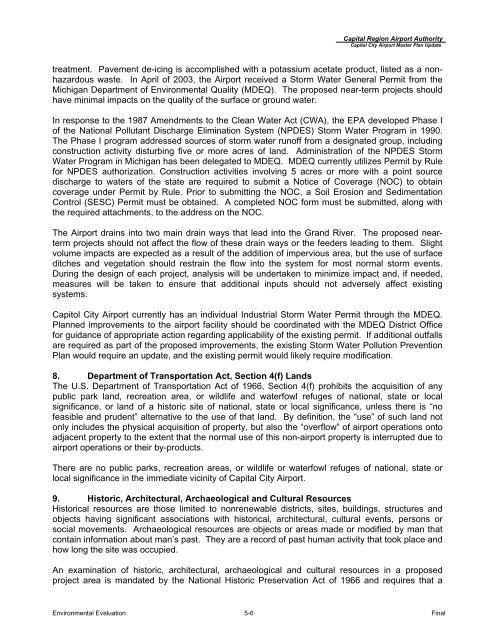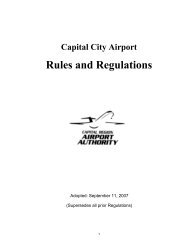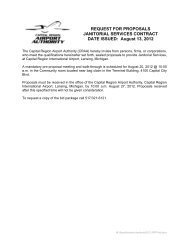Master Plan Update (pdf) - Lansing/Capital City Airport
Master Plan Update (pdf) - Lansing/Capital City Airport
Master Plan Update (pdf) - Lansing/Capital City Airport
Create successful ePaper yourself
Turn your PDF publications into a flip-book with our unique Google optimized e-Paper software.
<strong>Capital</strong> Region <strong>Airport</strong> Authority<br />
<strong>Capital</strong> <strong>City</strong> <strong>Airport</strong> <strong>Master</strong> <strong>Plan</strong> <strong>Update</strong><br />
treatment. Pavement de-icing is accomplished with a potassium acetate product, listed as a nonhazardous<br />
waste. In April of 2003, the <strong>Airport</strong> received a Storm Water General Permit from the<br />
Michigan Department of Environmental Quality (MDEQ). The proposed near-term projects should<br />
have minimal impacts on the quality of the surface or ground water.<br />
In response to the 1987 Amendments to the Clean Water Act (CWA), the EPA developed Phase I<br />
of the National Pollutant Discharge Elimination System (NPDES) Storm Water Program in 1990.<br />
The Phase I program addressed sources of storm water runoff from a designated group, including<br />
construction activity disturbing five or more acres of land. Administration of the NPDES Storm<br />
Water Program in Michigan has been delegated to MDEQ. MDEQ currently utilizes Permit by Rule<br />
for NPDES authorization. Construction activities involving 5 acres or more with a point source<br />
discharge to waters of the state are required to submit a Notice of Coverage (NOC) to obtain<br />
coverage under Permit by Rule. Prior to submitting the NOC, a Soil Erosion and Sedimentation<br />
Control (SESC) Permit must be obtained. A completed NOC form must be submitted, along with<br />
the required attachments, to the address on the NOC.<br />
The <strong>Airport</strong> drains into two main drain ways that lead into the Grand River. The proposed nearterm<br />
projects should not affect the flow of these drain ways or the feeders leading to them. Slight<br />
volume impacts are expected as a result of the addition of impervious area, but the use of surface<br />
ditches and vegetation should restrain the flow into the system for most normal storm events.<br />
During the design of each project, analysis will be undertaken to minimize impact and, if needed,<br />
measures will be taken to ensure that additional inputs should not adversely affect existing<br />
systems.<br />
Capitol <strong>City</strong> <strong>Airport</strong> currently has an individual Industrial Storm Water Permit through the MDEQ.<br />
<strong>Plan</strong>ned improvements to the airport facility should be coordinated with the MDEQ District Office<br />
for guidance of appropriate action regarding applicability of the existing permit. If additional outfalls<br />
are required as part of the proposed improvements, the existing Storm Water Pollution Prevention<br />
<strong>Plan</strong> would require an update, and the existing permit would likely require modification.<br />
8. Department of Transportation Act, Section 4(f) Lands<br />
The U.S. Department of Transportation Act of 1966, Section 4(f) prohibits the acquisition of any<br />
public park land, recreation area, or wildlife and waterfowl refuges of national, state or local<br />
significance, or land of a historic site of national, state or local significance, unless there is “no<br />
feasible and prudent” alternative to the use of that land. By definition, the “use” of such land not<br />
only includes the physical acquisition of property, but also the “overflow” of airport operations onto<br />
adjacent property to the extent that the normal use of this non-airport property is interrupted due to<br />
airport operations or their by-products.<br />
There are no public parks, recreation areas, or wildlife or waterfowl refuges of national, state or<br />
local significance in the immediate vicinity of <strong>Capital</strong> <strong>City</strong> <strong>Airport</strong>.<br />
9. Historic, Architectural, Archaeological and Cultural Resources<br />
Historical resources are those limited to nonrenewable districts, sites, buildings, structures and<br />
objects having significant associations with historical, architectural, cultural events, persons or<br />
social movements. Archaeological resources are objects or areas made or modified by man that<br />
contain information about man’s past. They are a record of past human activity that took place and<br />
how long the site was occupied.<br />
An examination of historic, architectural, archaeological and cultural resources in a proposed<br />
project area is mandated by the National Historic Preservation Act of 1966 and requires that a<br />
Environmental Evaluation 5-6 Final




